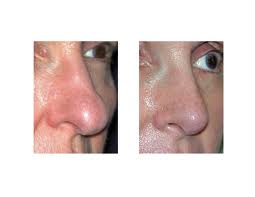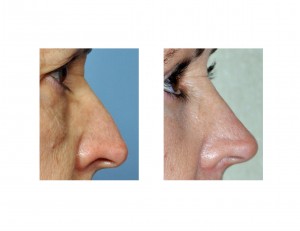As we age our face undergoes many changes. Almost all of these age-related tissue changes are a downward drift due to gravity as tissues loosen and fall. The development of sagging eyebrows, malar bags, deepening nasolabial folds, jowls and neck wattles are the most recognizeable of these signs. But other facial features also age although they are less well described.
The nose, the central feature of everyone;s face, also has distinct aging characteristics. While traditionally thought as being a fixed structure of bone, cartilage and skin that undergoes little alteration throughout life, that is now known to be not true. With age the nasal tip loses support and drops downward. This not only decreases the nasolabial angle but also creates the appearance of a pseudohump. As the nose undergoes this counterrotation at he tip, it actually lengthens. This the old saying that our nose gets longer as we get older is anatomically true.
These age-related movements of the nose are exacerbated by changes in the underlying facial bones. Resorption of the pyriform aperture causes further recession of the support of the nasal soft tissues, worsening the decrease in the nasolabial angle.
The objective of rhinoplasty surgery is to transform the nose by changing its structure for improved nasal shape and putting it in better proportion to the rest of the face. The traditional maneuvers of hump reduction, creating a smooth dorsal line, tip rotation and narrowing all work together to create a shorter nose and more pleasing nasolabial angle. Such changes seem to be the antithesis of what happens in the aging nose, raising the question of whether rhinoplasty can also make one look younger as well.
In a paper published in the January/February 2012 issue of the Archives of Facial Plastic Surgery, the effect of rhinoplasty on aging appearance was studied. Before and after pictures of over fifty rhinoplasty patients were evaluated by fifty laypersons for their perception of patient ages. Measurements were also made for dorsal humps and nasolabial angles. The results showed that rhinoplasty made patient look younger after surgery by 1.3 years on average. Dorsal hump reduction was associated with 1.6 years younger look and opening the nasolabial angle reduced patient’s perceived ages by 1.3 to 2 years based on the degree of angular change. The greater the amount of hump reduction and tip rotation improved the rhinoplasty’s rejuvenative effect. Older patients also had a greater rejuvenative effect from their rhinoplasty surgery.


Dr. Barry Eppley
Indianapolis, Indiana


